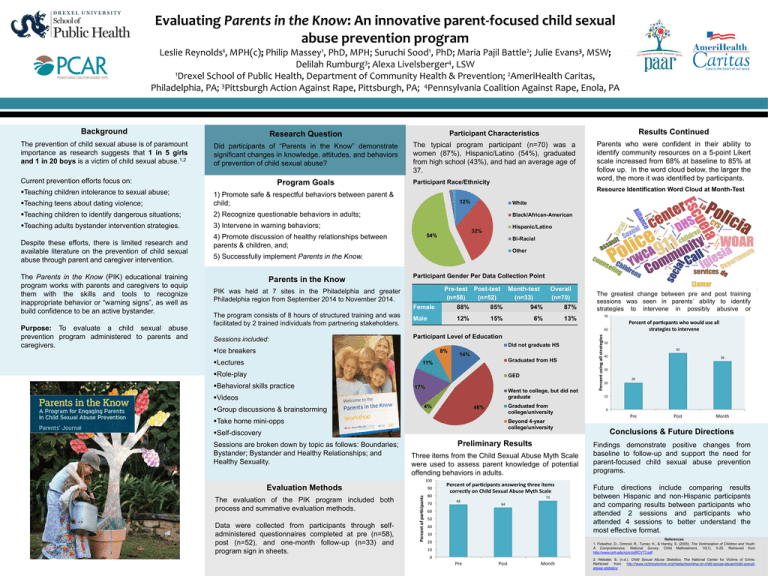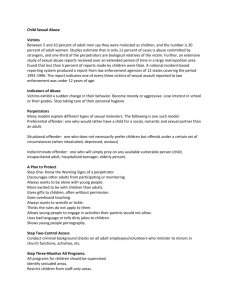Parents in the Know abuse prevention program
advertisement

Evaluating Parents in the Know: An innovative parent-focused child sexual abuse prevention program Leslie Reynolds1, MPH(c); Philip Massey1, PhD, MPH; Suruchi Sood1, PhD; Maria Pajil Battle2; Julie Evans3, MSW; Delilah Rumburg3; Alexa Livelsberger4, LSW 1Drexel School of Public Health, Department of Community Health & Prevention; 2AmeriHealth Caritas, 3 4 Philadelphia, PA; Pittsburgh Action Against Rape, Pittsburgh, PA; Pennsylvania Coalition Against Rape, Enola, PA Background Research Question Participant Characteristics Results Continued The prevention of child sexual abuse is of paramount importance as research suggests that 1 in 5 girls and 1 in 20 boys is a victim of child sexual abuse.1,2 Did participants of “Parents in the Know” demonstrate significant changes in knowledge, attitudes, and behaviors of prevention of child sexual abuse? The typical program participant (n=70) was a women (87%), Hispanic/Latino (54%), graduated from high school (43%), and had an average age of 37. Parents who were confident in their ability to identify community resources on a 5-point Likert scale increased from 68% at baseline to 85% at follow up. In the word cloud below, the larger the word, the more it was identified by participants. Current prevention efforts focus on: Teaching children intolerance to sexual abuse; Program Goals Participant Race/Ethnicity Resource Identification Word Cloud at Month-Test Teaching teens about dating violence; 1) Promote safe & respectful behaviors between parent & child; Teaching children to identify dangerous situations; 2) Recognize questionable behaviors in adults; Black/African-American Teaching adults bystander intervention strategies. 3) Intervene in warning behaviors; Hispanic/Latino Despite these efforts, there is limited research and available literature on the prevention of child sexual abuse through parent and caregiver intervention. The Parents in the Know (PIK) educational training program works with parents and caregivers to equip them with the skills and tools to recognize inappropriate behavior or “warning signs”, as well as build confidence to be an active bystander. Purpose: To evaluate a child sexual abuse prevention program administered to parents and caregivers. 12% 32% 54% 4) Promote discussion of healthy relationships between parents & children, and; White Bi-Racial Other 5) Successfully implement Parents in the Know. Parents in the Know Participant Gender Per Data Collection Point Pre-test (n=58) PIK was held at 7 sites in the Philadelphia and greater Philadelphia region from September 2014 to November 2014. Post-test (n=52) Month-test (n=33) Overall (n=70) Female 88% 85% 94% 87% The program consists of 8 hours of structured training and was facilitated by 2 trained individuals from partnering stakeholders. Male 12% 15% 6% 13% Sessions included: Participant Level of Education The greatest change between pre and post training sessions was seen in parents’ ability to identify strategies to intervene in possibly abusive or problematic situations, based on 7 strategies Did not graduate HS Ice breakers 8% Lectures 14% Graduated from HS 11% Role-play GED Behavioral skills practice 17% Went to college, but did not graduate Videos Group discussions & brainstorming Take home mini-opps Self-discovery Sessions are broken down by topic as follows: Boundaries; Bystander; Bystander and Healthy Relationships; and Healthy Sexuality. Evaluation Methods The evaluation of the PIK program included both process and summative evaluation methods. Data were collected from participants through selfadministered questionnaires completed at pre (n=58), post (n=52), and one-month follow-up (n=33) and program sign in sheets. 4% 46% Graduated from college/university Beyond 4-year college/university Preliminary Results Three items from the Child Sexual Abuse Myth Scale were used to assess parent knowledge of potential offending behaviors in adults. Conclusions & Future Directions Findings demonstrate positive changes from baseline to follow-up and support the need for parent-focused child sexual abuse prevention programs. Future directions include comparing results between Hispanic and non-Hispanic participants and comparing results between participants who attended 2 sessions and participants who attended 4 sessions to better understand the most effective format. References 1. Finkelhor, D., Ormrod, R., Turner, H., & Hamby, S. (2005). The Victimization of Children and Youth: A Comprehensive, National Survey. Child Maltreatment, 10(1), 5-25. Retrieved from http://www.unh.edu/ccrc/pdf/CV73.pdf 2. Webster, S. (n.d.). Child Sexual Abuse Statistics. The National Center for Victims of Crime. Retrieved from http://www.victimsofcrime.org/media/reporting-on-child-sexual-abuse/child-sexualabuse-statistics






